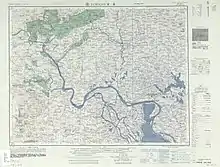I-ch'ang
See also: Ichang
English
Etymology
From Mandarin 宜昌 (Yíchāng) Wade–Giles romanization: I²-chʻang¹.[1]
Proper noun
I-ch'ang
- Alternative form of Yichang
- 1904, C. D. Tenney, “中國 [Zhōngguó, The Chinese Empire]”, in Geography of Asia, New York: MacMillan and Co, →OCLC, page 3:
- The Yang-tzŭ-chiang (揚子江) is about 3,300 miles long ; it is navigable for large steamers for 600 miles to Hankow (漢口) and for light-draught steamers 360 miles further to I-chʻang (宜昌).
Above I-chʻang there are rapid which are difficult to pass.
- 1911, Ethel Daniels Hubbard, Under Marching Orders, →OCLC, page 75:
- River streamers soon connected Nanking with Hankow, four hundred miles beyond, and finally, small steamboats sailed triumphantly up stream to I-ch'ang. Beyond I-ch'ang were the fierce rapids of the upper Yang-tzŭ, where foreign enterprise gave way before simple Chinese ingenuity.
- 1988, Lyman P. Van Slyke, Yangtze: Nature History and the River, Addison-Wesley Publishing Company, →ISBN, →LCCN, →OCLC, →OL, page 20:
- Just below Hsi-ling Gorge lies the small city of I-ch'ang, the first river port beyond the gorges.
- For more quotations using this term, see Citations:I-ch'ang.
Translations
Yichang — see Yichang
References
- Yichang, Wade-Giles romanization I-ch’ang, in Encyclopædia Britannica
Further reading
- “I-ch'ang”, in Collins English Dictionary.
- “I-ch’ang”, in Merriam-Webster Online Dictionary, Springfield, Mass.: Merriam-Webster, 1996–present.
- “I-ch'ang” in TheFreeDictionary.com, Huntingdon Valley, Pa.: Farlex, Inc., 2003–2024.
This article is issued from Wiktionary. The text is licensed under Creative Commons - Attribution - Sharealike. Additional terms may apply for the media files.
